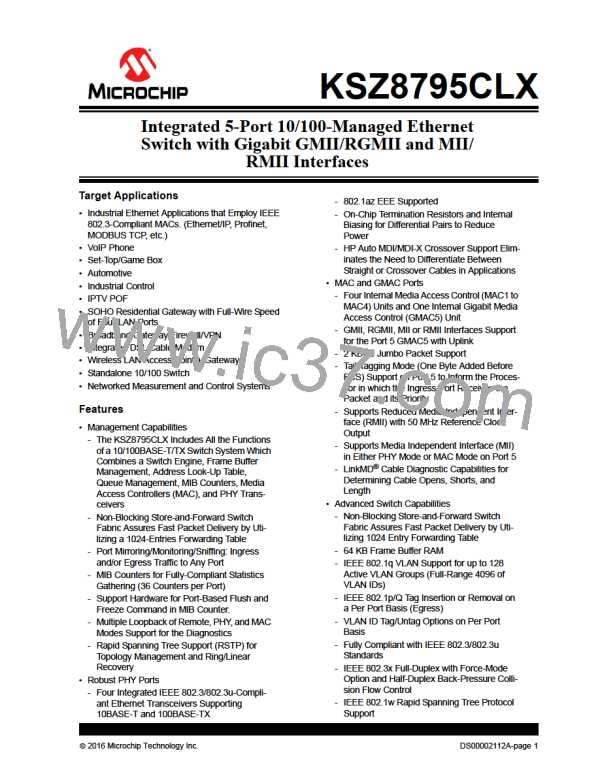KSZ8795CLX
skipped and carrier sense is generated immediately, reducing the chance of further colliding and maintaining carrier
sense to prevent reception of packets. To ensure no packet loss in 10BASE-T or 100BASE-TX half-duplex modes, the
user must enable the following:
• Aggressive backoff (Register 3, Bit[0])
• No excessive collision drop (Register 4, Bit[3])
• Back pressure (Register 4, Bit[5])
These bits are not set as the default because this is not the IEEE standard.
3.2.7
BROADCAST STORM PROTECTION
The KSZ8795CLX has an intelligent option to protect the switch system from receiving too many broadcast packets.
Broadcast packets are normally forwarded to all ports except the source port and thus use too many switch resources
(bandwidth and available space in transmit queues). The KSZ8795CLX has the option to include “multicast packets” for
storm control. The broadcast storm rate parameters are programmed globally and can be enabled or disabled on a per
port basis. The rate is based on a 50 ms (0.05s) interval for 100BT and a 500 ms (0.5s) interval for 10BT. At the begin-
ning of each interval, the counter is cleared to zero and the rate limit mechanism starts to count the number of bytes
during the interval. The rate definition is described in Registers 6 and 7. The default setting for Registers 6 and 7 is 0x4A
(74 decimal). This is equal to a rate of 1%, calculated as follows:
148.80 frames/sec x 50 ms (0.05s)/interval x 1% = 74 frames/interval (approx.) = 0x4A
3.3
Switch Core
3.3.1
ADDRESS LOOK-UP
The internal look-up table stores MAC addresses and their associated information. It contains a 1K unicast address
table plus switching information. The KSZ8795CLX is guaranteed to learn 1K addresses and distinguishes itself from a
hash-based look-up table, which, depending on the operating environment and probabilities, may not guarantee the
absolute number of addresses it can learn.
3.3.2
LEARNING
The internal look-up engine updates its table with a new entry if the following conditions are met:
• The received packet’s source address (SA) does not exist in the look-up table.
• The received packet is good; the packet has no receiving errors and is of legal length.
The look-up engine inserts the qualified SA into the table, along with the port number and time stamp. If the table is full,
the last entry of the table is deleted first to make room for the new entry.
3.3.3
MIGRATION
The internal look-up engine also monitors whether a station is moved. If this occurs, it updates the table accordingly.
Migration happens when the following conditions are met:
• The received packet’s SA is in the table but the associated source port information is different.
• The received packet is good; the packet has no receiving errors and is of legal length.
The look-up engine will update the existing record in the table with the new source port information.
3.3.4
AGING
The look-up engine will update the time stamp information of a record whenever the corresponding SA appears. The
time stamp is used in the aging process. If a record is not updated for a period of time, the look-up engine will remove
the record from the table. The look-up engine constantly performs the aging process and will continuously remove aging
records. The aging period is 300s (±75s). This feature can be enabled or disabled through Register 3 Bit[2].
3.3.5
FORWARDING
The KSZ8795CLX will forward packets using an algorithm that is depicted in the following flowcharts. Figure 3-4 shows
stage one of the forwarding algorithm where the search engine looks up the VLAN ID, static table, and dynamic table
for the destination address, and comes up with “port to forward 1” (PTF1). PTF1 is then further modified by the spanning
tree, IGMP snooping, port mirroring, and port VLAN processes and authentication to come up with “port to forward 2”
(PTF2), as shown in Figure 3-4. The authentication and ACL have highest priority in the forwarding process; ACL result
will overwrite the result of the forwarding process. This is where the packet will be sent.
2016 Microchip Technology Inc.
DS00002112A-page 19

 MICREL [ MICREL SEMICONDUCTOR ]
MICREL [ MICREL SEMICONDUCTOR ]